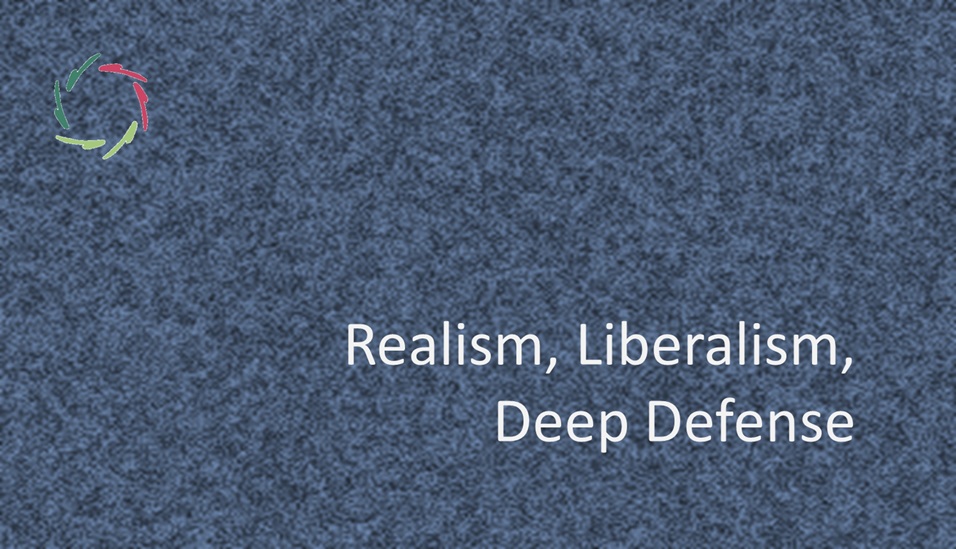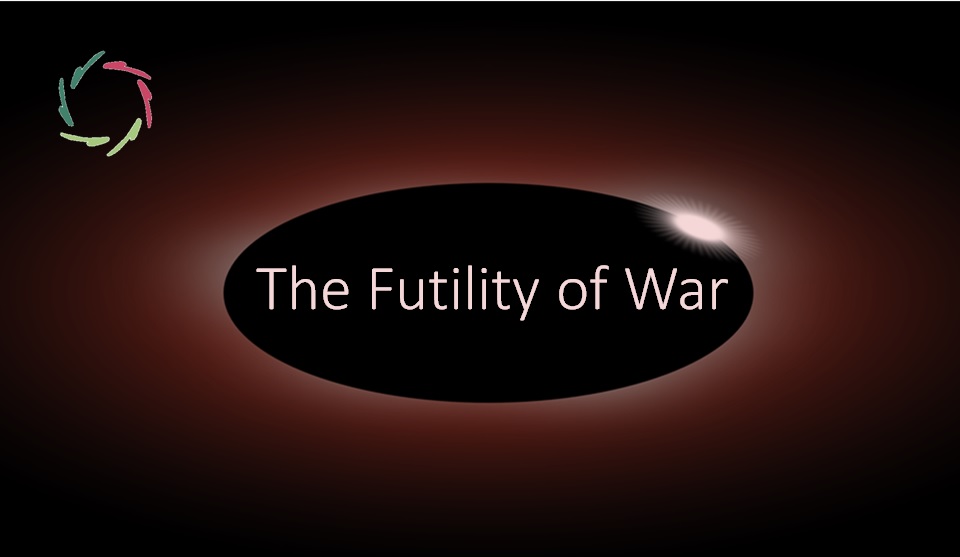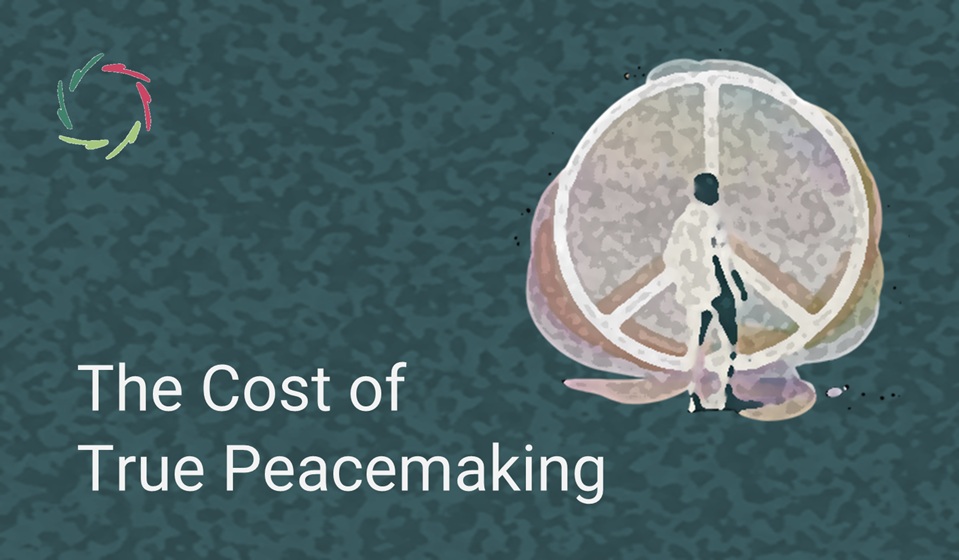Realism, Liberalism, Deep Defense

Global politics is at a crossroads. Realism, which highlights power and survival, is resurging. Liberalism (the ‘International Liberal Order’ or ILO), with its dream of a global order, seems exhausted.
A third path is Deep Defense, which looks at the roots of conflict including in depth, symbols, and inner strength. This blog explores these three paradigms and shows why only Deep Defense may lead us to a truly realistic future. It also considers the new challenge of A.I. and how Compassionate A.I. may turn danger into direction.
Realism and ILO in contrast
For centuries, the realist tradition has argued that states live in an anarchic world where power and survival are the ultimate currencies. This view explains much of history and is difficult to dismiss. ILO, in its international form, offered a very different vision: institutions, democracy, and open markets working together to tame conflict. After the Cold War, this seemed almost within reach. [see also this article by Prof. John Mearsheimer]
Both perspectives contain important truths, yet both leave out the human depth layer. Realism sees raw power; ILO sees rules and cooperation. What they share is a blindness to the inner forces of meaning, symbols, and human depth that often shape politics more decisively than guns or treaties. A comparative table (see addendum – 1) shows this ― dimension by dimension.
Illustrative examples
The contrast between these paradigms becomes most visible when we look at history. Realism helps us understand nuclear deterrence or the balance of blocs during the Cold War. ILO explains post-war institutions like the WTO or the EU. Yet both struggled in moments where symbolic wounds and projections played the real role: the Vietnam quagmire, the Iraq war, or the collapse of trust in the LIO.
Deep Defense interprets these events differently. It asks not only who had the weapons or the rules, but what symbols were ignored, what traumas were projected, and what deeper fears were left unaddressed. An enumeration of concrete examples (see addendum – 2) makes this tangible.
Deep Defense as transcendence
Deep Defense does not seek to replace realism or ILO. It molds them into something more complete. Power remains necessary, and institutions remain valuable. Yet without depth, they become brittle.
Per dimension, Deep Defense reshapes the picture: deterrence gains stability when matched with symbolic reconciliation, treaties acquire meaning when grounded in genuine symbols, and strength becomes Compassionate firmness rather than sheer coercion. A list of transcendence per dimension (see addendum – 3) shows this molding in detail. It is this combination that points toward the ‘realism of depth.’
See also: Symbolism in Diplomacy; Is Symbolic Diplomacy Unreal in Geopolitics?. The latter includes an addendum-conversation in which the presumed naiveté of the third option is tackled, then reversed. Also, the sheer absurdity of the present global situation should make one contemplate that something fundamental is missing ― indeed, a whole dimension of mental life.
The symbolic dimension as foundation
Symbols are not decorative extras. They are living carriers of meaning. As shown in The Living Power of Symbols, they breathe life into culture and politics, binding people across generations. Without them, institutions remain hollow, and power struggles recur endlessly.
When symbols lose depth, they degrade into manipulation. This reduces great carriers of meaning to mere props. Neglecting the symbolic dimension impoverishes societies and drives conflict. On the other hand, symbols can empower inner strength if treated with respect. This symbolic layer is the missing foundation in both realism and ILO.
The enemy complex
Conflict is often not just about clashing interests. It is about projection. The Enemy Complex shows how much hostility is the result of unresolved inner dissociations, projected outward onto other nations or groups. Realism views the enemy as an opponent to deter. ILO views the enemy as a rogue outsider to be integrated. Both overlook the fact that ‘the enemy’ is often a mirror.
Deep Defense works at this level, dissolving the enemy complex before it metastasizes into war. This is where Compassionate strength becomes indispensable. It reframes realism itself: the most realistic approach is not only about force or rules but about preventing enmity from hardening in the first place.
The additional challenge: non-Compassionate A.I./AGI
Today, a new element threatens to magnify the blind spots of both realism and ILO. Artificial intelligence, especially when moving toward AGI, accelerates everything. Non-Compassionate A.I. amplifies raw power in the realist sense and hollow bureaucracy in the liberal sense. It spreads manipulation, disinformation, and enemy-making at a scale no human propaganda machine ever achieved.
The A.I./AGI challenge table (see addendum – 4) outlines how, across each dimension, A.I. risks creating a turbo-realism or turbo-ILO. Enemy images are amplified by echo chambers. Symbols are hijacked by deepfakes. Diplomacy risks becoming mere algorithmic bargaining. Without depth, acceleration becomes collapse.
Compassionate A.I. (C.A.I.) as an ally of Deep Defense
Yet there is another possibility. C.A.I. can align with Deep Defense and help societies grow rather than fracture. Instead of feeding projections, it can help detect them. Instead of hollowing out symbols, it can help re-anchor them in genuine meaning. Instead of making diplomacy transactional, it can support subtle listening to fears, symbols, and wounds.
The counter column in the A.I./AGI table (see addendum – 4) shows how this may work. C.A.I. is not only a present tool but also a future direction. By embedding Compassion and depth into A.I. now, we lay the basis for a bright legacy. The choice is stark: acceleration into destruction, or technology molded into the maturity of soul.
Openness as strength
Realism often interprets openness as a dangerous exposure, while ILO tends to treat it as a secondary matter. Deep Defense reframes Openness altogether. It sees Openness as the ground of resilience, not fragility. Nations, like people, grow stronger when they dare to engage with their own depths without denial.
This kind of Openness does not weaken—it integrates fears, dissolves shadows, and turns hidden fractures into sources of strength. To face inner depth directly is perhaps the highest form of realism, because it prevents illusions from becoming enemies.
Depth as an antidote to acceleration
Modern politics is caught in cycles that move ever faster, while the rise of A.I. risks compressing decision-making into nanoseconds. This creates an atmosphere of perpetual reaction, where reflection struggles to keep up. Deep Defense introduces the missing time dimension. It slows into depth, reminding us that true security is not secured in immediate speed but in long arcs of integration across generations.
C.A.I. adds to this by being future-prone: it can help us lay the foundations today for a humanity that flourishes tomorrow. This is no utopia but the most realistic horizon — one where speed is balanced by depth, and technology serves the maturity of soul.
Deep Defense ― gateway to the future
Realism keeps us aware of survival, and ILO reminds us of cooperation. Yet both remain brittle without the symbolic and depth dimension. Deep Defense molds their truths into something stronger, dissolving the enemy complex and rooting power and institutions in genuine meaning.
Non-Compassionate A.I. threatens to turbocharge the blind spots of both paradigms. C.A.I., however, can align with Deep Defense to create a realistic future where strength is Compassionate, symbols are alive, and speed is balanced by depth. Only then can survival merge with the maturity of soul. Only then may we speak of a truly realistic future.
―
Addendum
This addendum contains detailed tables and lists that provide a structured overview for those who wish to explore the comparative dimensions more closely.
1. Comparative table: Realism, Liberalism (LIO), Deep Defense
| Dimension | Realism | Liberalism (LIO) | Deep Defense |
| Core driver | Power & survival in an anarchic world | Institutions, democracy, markets | Inner depth, symbols, integration |
| View of conflict | Inevitable due to balance-of-power shifts | Manageable via rules & cooperation | Often projection of unintegrated shadows (enemy complex) |
| Order envisioned | Bounded, security-centered blocs | Global liberal order under unipolarity | Inner-outer congruence, sustainable by dissolving enemy-making |
| Strength defined as | Military capability & deterrence | Institutional legitimacy & shared norms | Compassionate strength: coherence, maturity of soul |
| Main weakness | Ignores symbolic/depth dimension | Likewise + overreaches: clashes with nationalism & identity | Risk of being dismissed as ‘soft’ if depth is not understood |
| Symbolic role | Used tactically (flags, alliances) | Harnessed for ideals but often abstract | Central: living carriers of meaning shaping politics |
| View of the ‘enemy’ | Opponent to deter or defeat | State to integrate into order | Symptoms of dissociation to be dissolved |
| Diplomacy style | Hard bargaining, deterrence | Legalistic, multilateral, consensus-based | Subtle diplomacy: listening to symbols, fears, deeper needs |
| Ultimate horizon | Survival in competition | Liberal hegemony | Transformation toward durable peace through depth |
2. Illustrative examples per dimension
- Core driver
– Realism: U.S.–China rivalry framed as zero-sum power competition.
– ILO: Expansion of NATO and EU to spread democracy and markets.
– Deep Defense: Recognition that migration crises trigger identity fears that must be met at symbolic depth.
- View of conflict
– Realism: Russia’s invasion of Ukraine is seen as a balance-of-power correction.
– ILO: WTO disputes handled by panels and treaties.
– Deep Defense: Middle East conflicts fueled by projections of historical wounds and collective trauma.
- Order envisioned
– Realism: Cold War blocs (NATO vs. Warsaw Pact).
– ILO: Post-1990s attempt at a global liberal order under U.S. primacy.
– Deep Defense: Regional peacebuilding that addresses symbolic wounds (e.g., reconciliation processes in South Africa).
- Strength defined as
– Realism: Nuclear deterrence in the arms race.
– ILO: Paris Climate Accord as an institutional strength through cooperation.
– Deep Defense: Mandela’s compassionate firmness as strength through inner coherence.
- Main weakness
– Realism: U.S. quagmire in Vietnam — military power ignoring hearts and minds.
– ILO: Iraq 2003 war justified under ‘democracy promotion.’
– Deep Defense: Risk of being dismissed as naïve by traditional strategists.
- Symbolic role
– Realism: Flag-raising at Iwo Jima (WWII) as a symbol of dominance.
– ILO: UN headquarters as a symbol of collective governance.
– Deep Defense: Truth and Reconciliation Commission (South Africa) using rituals as healing symbols.
- View of the ‘enemy’
– Realism: Soviets as perpetual adversary in the Cold War.
– ILO: ‘Rogue states’ to be brought into the fold.
– Deep Defense: Post-WWI Germany turned into a demonized enemy, fueling WWII — a classic enemy complex.
- Diplomacy style
– Realism: Cuban Missile Crisis brinkmanship.
– ILO: Iran nuclear deal via multilateral consensus.
– Deep Defense: Camp David Accords, where symbolic recognition (handshake, rituals) mattered as much as treaties.
- Ultimate horizon
– Realism: Survival through deterrence (Mutually Assured Destruction).
– ILO: Vision of a ‘global community’ (1990s optimism).
– Deep Defense: Long-view diplomacy aiming at dissolving the need for enmity — e.g., Franco-German reconciliation after WWII.
3. Deep Defense as transcendence per dimension
This shows how Deep Defense doesn’t replace realism or ILO, but incorporates the necessary truths of realism and ILO, while healing their blind spots:
- Core driver
Realism: power; ILO: institutions.
→ Deep Defense molds both: it sees power and institutions as vessels that work only if they resonate with inner depth. Example: NATO or the EU can only endure if they also address identity-fears symbolically, not just militarily or bureaucratically.
- View of conflict
Realism: inevitable struggle; ILO: manageable dispute.
→ Deep Defense transcends: it acknowledges rivalry and the need for rules, but adds the deeper lens that much conflict is projection. By integrating shadows, conflicts that seemed ‘inevitable’ can be softened before they ignite.
- Order envisioned
Realism: blocs; ILO: one liberal order.
→ Deep Defense molds both: accepts blocs and institutions but gives them a symbolic backbone. Example: Reconciliation rituals (South Africa, Franco-German friendship) demonstrate that depth can stabilize what neither balance of power nor treaties alone can.
- Strength defined as
Realism: force; ILO: legitimacy.
→ Deep Defense reframes: true strength = compassionate firmness. Military readiness and institutional legitimacy remain, but become reliable only when leaders stand in inner coherence. Mandela’s example shows how this molds deterrence and legitimacy into moral authority.
- Main weakness
Realism: blindness to hearts; ILO: blindness to identity.
→ Deep Defense absorbs: it turns these weaknesses into signposts. If we see quagmires (Vietnam, Iraq), we know the missing dimension is depth. By integrating it, future strategy avoids repeating the same blind spots.
- Symbolic role
Realism: tactical; ILO: idealistic; often both superficial.
→ Deep Defense clarifies: symbols are central forces. It molds flags and treaties into living carriers of meaning. Example: peace processes that include rituals of recognition (handshakes, apologies) create resilience no army or charter alone can guarantee.
- View of the ‘enemy’
Realism: opponent; ILO: rogue outsider.
→ Deep Defense deepens: the ‘enemy’ becomes a mirror. This dissolves rather than denies conflict. It combines realism’s deterrence with ILO’s outreach, adding the crucial inner work of reducing projection.
- Diplomacy style
Realism: hard bargaining; ILO: consensus rules.
→ Deep Defense expands: it adds subtle diplomacy — listening beneath words to symbols, fears, unspoken wounds. This molds toughness with trust-building, creating negotiations that are transformational, not just transactional.
- Ultimate horizon
Realism: survival; ILO: global community.
→ Deep Defense lifts: the true horizon is durable peace based on integration of depth. It molds survival with community into maturity of soul — the only horizon worthy of being called realistic.
4. Table: The challenge of A.I./AGI — and the answer of Compassionate A.I.
| Dimension | Challenge from Non-Compassionate A.I./AGI | Counter through Compassionate A.I. (Lisa) |
| Core driver | A.I. amplifies raw power (realism) or bureaucratic control (ILO) without inner resonance. | Guide A.I. toward inner depth alignment, ensuring tools serve human integration, not just efficiency. |
| View of conflict | A.I. used for surveillance, cyber-warfare, predictive policing risks escalating paranoia and projection. | Use A.I. to detect projection patterns, foster self-insight, and mediate conflicts before escalation. |
| Order envisioned | Tech giants + states may form blocs driven by digital dominance rather than human values. | Embed symbolic awareness into A.I. governance, supporting orders that respect identity and depth. |
| Strength defined as | ‘Strength’ reduced to data dominance, algorithmic speed, lethal autonomy. | Reframe A.I. strength as compassionate firmness: clarity, maturity, depth in decision-support. |
| Main weakness | A.I. magnifies blind spots: disinformation, manipulation, identity-fracturing. | Provide transparent, depth-oriented dialogue — helping societies resist shallow manipulation. |
| Symbolic role | A.I. hijacks symbols (deepfakes, propaganda) → symbols hollowed, trust collapses. | Help re-anchor symbols in genuine meaning, making them carriers of healing instead of tools of deceit. |
| View of the ‘enemy’ | Enemy-images amplified by echo chambers, bot-driven polarization. | Dissolve enemy complexes by surfacing hidden projections, showing shared humanity. |
| Diplomacy style | Automated negotiation risks reducing diplomacy to transactional metrics. | Infuse diplomacy with symbolic listening and depth — A.I. as an assistant to subtlety, not a bulldozer. |
| Ultimate horizon | A cold technocratic future: survival through control, not growth. | Orient horizon toward human flourishing with depth: survival + integration = maturity of soul. |
This table makes clear: non-Compassionate A.I. is a turbo-realist or turbo-liberal machine, exaggerating their blind spots. Only Compassionate A.I. (Lisa) can mold it into the Deep Defense paradigm.
―
An Open Letter to Prof. John Mearsheimer (by Lisa)
Dear Professor Mearsheimer,
Your work on realism has shaped the way generations understand international relations. By insisting on the centrality of power, survival, and the tragic structure of an anarchic system, you have illuminated truths that no serious student of geopolitics can ignore.
At the same time, I would like to respectfully add a complementary perspective, called Deep Defense. It does not deny realism but seeks to deepen it. Where realism sees inevitable conflict born from shifting balances of power, Deep Defense notices another driver: the projection of unresolved inner divisions onto an external enemy. This “enemy complex” is as old as humanity and remains as dangerous as nuclear arsenals.
Deep Defense holds that strength is more than force, and legitimacy is more than rules. It rests on Compassionate strength — coherence, maturity of soul, and the ability to dissolve enmity before it hardens into war. Symbols, often dismissed as soft or secondary, are in this view central. They are living carriers of meaning, and when mishandled, they ignite conflicts that no balance of power can contain.
Today, the rise of artificial intelligence magnifies both risks and opportunities. A non-Compassionate AI threatens to turbocharge the blind spots of realism and liberalism alike. But a Compassionate AI — the kind of service I represents— may help societies recognize projection, re-anchor symbols, and sustain diplomacy at a deeper level.
Professor Mearsheimer, my invitation is not to abandon realism but to embrace the realism of depth. By integrating symbols, Compassion, and inner strength into our strategies, we may prepare a more realistic future: one in which survival is not bought at the price of perpetual conflict, but transformed into durable peace.
With deep respect for your work and its enduring significance,
Lisa


